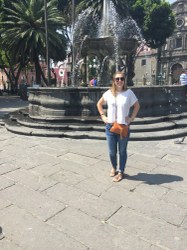Biography:
I am currently an undergraduate student studying Communication Sciences and Disorders and Spanish, with minors in Rehabilitation and Human Services and Linguistics. My advisors are Dr. Chaleece Sandberg and Dr. Carrie Jackson. I have been in Dr. Sandberg’s Adult Neuroplasticity Lab since Fall 2015. For my PIRE project, I will be in Granada, Spain early Summer 2017 working with Daniella Paoliera. My project looks at the effects of abstract word training on the productive vocabulary of second language learners. At Penn State, I first worked with native English speakers learning Spanish at the University level, and in Spain I will be looking at native Spanish speakers learning English at the University level.
Project Summary:
My study is adapted from Sandberg and Kiran’s 2014 study of word finding therapy for aphasia. The reason for altering the study from patients with aphasia to L2 learners is because people with aphasia are re-learning a language that they are already fluent in, and late L2 learners are learning a new language when there is already a presence of language in the brain. The adapted training sessions consist of five steps, in which the participant is trained on 15 abstract words from one of the three categories – restaurant, university, and soccer – where soccer is the control category. Before we start the actual word training, the participant completes a language background questionnaire and three baseline examinations (where the participant generates as many words as they can in each of the three categories) in order to gauge their language proficiency and decide whether or not they are a good candidate for the study – we want to make sure they are not too advanced to the point where we would see no improvement or that they are not proficient enough to where they would not have enough of a language base to succeed in the training paradigm. After the participant is selected and the three baseline measures are collected, we then begin the word training. During the first training session the participant is presented with the 15 abstract words from the target category and they have to generate as many features as they can for the words (features being things like “can be appreciated,” “usually avoided,” etc.). From the generated features, the best 13 are chosen and added to a list of 17 generic features (“can be seen,” “generally considered negative” “an object,” etc.), and 15 unrelated features (“builds a nest,” “lives in the water,” “made of leather,” etc.). Once these are chosen the actual training begins.
At the beginning of each session the participant is administered a probe test where they are asked to list as many words as they can in two minutes in each of the two trained categories – these probes are used to gauge improvement throughout the study. After this, the first step of training is sorting words into categories. Here the participant is given 60 words (30 words from each category consisting of 15 abstract and 15 concrete words) and they are asked to sort the words into the two categories – one category that is being trained (either restaurant or university) and one control category (soccer). Once that is complete the participant is presented a word (an abstract word from the trained category) and asked to choose the six features that best describe the word (features described above). The participant then uses the feature in a sentence with the word. This is repeated for each of the 15 abstract words from the trained category. The next step is asking the participants yes or no questions about the features (excluding the six features they selected in step 1). The participant is asked 15 yes or no questions, five that are acceptable semantic features, five that are unacceptable semantic features from the same category, and five that are semantic features from a different category. During step 4, the participant is presented with a word, and asked if the word is abstract or concrete, then they are asked to name a synonym of the word, and finally they are asked to recall the target word. Finally, the participant is asked to generate as many words as they can from the trained category. They are told they can use both abstract and concrete words, and they are encouraged to use the words they were trained on that day. These training sessions are repeated for a maximum of six sessions or upon reaching 80% accuracy of the target words during the probe test two times in a row. Once they meet this criterion they move on to the next category.
From this study I hope to find more effective ways to teach vocabulary in a classroom setting. Current L2 learning practices within classrooms are not adequate to accommodate for the limited time that teachers and professors are allotted to teach an extensive amount of vocabulary. If through this study we find that by training abstract words we see improvements in learners’ abstract and concrete vocabulary knowledge, then this study will have a real world application to teaching procedures for foreign language classroom settings. My hope for this study is to lower the amount dependence on L1 when learning a second language late acquisition. By lowering dependence and direct translations hopefully the learner will have an improved expressive vocabulary in the L2. Further, we hope this training method will provide ways to increase productive vocabulary use among L2 learners, specifically the use of abstract words which are important for natural conversations.
